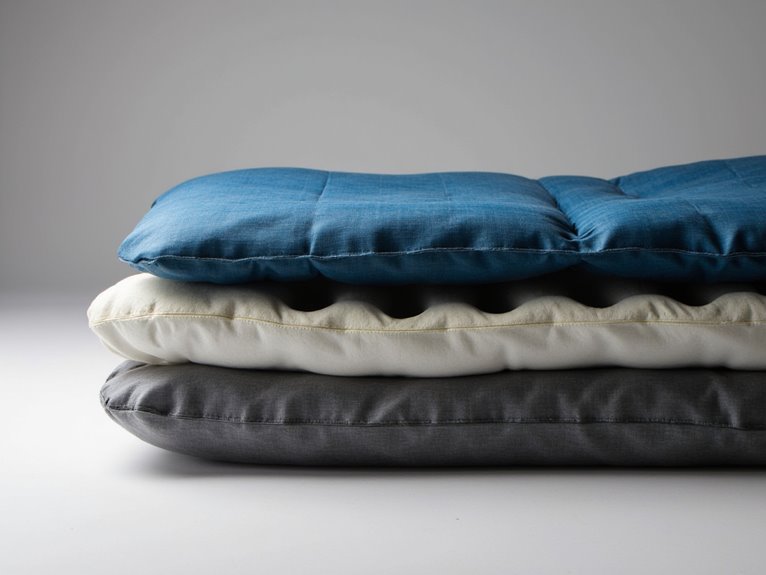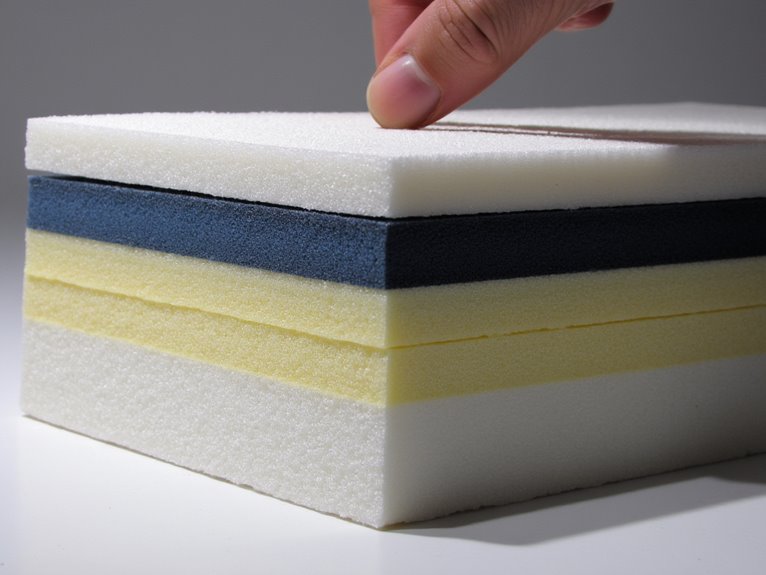Sleeping Pad Thickness: How It Affects Comfort and Insulation
Your sleeping pad’s thickness directly impacts both comfort and thermal performance, with every additional inch providing exponentially better pressure point relief and ground insulation. Thickness ranges from 1-6 inches, with side sleepers requiring minimum 2.5 inches while back sleepers can manage with 2 inches. However, thickness alone doesn’t guarantee warmth—a 2-inch pad with R-value 6.0 outperforms a 3-inch pad rated R-2.5. Understanding the complete relationship between thickness, insulation technology, and sleep position requirements will optimize your outdoor rest experience.
We are supported by our audience. When you purchase through links on our site, we may earn an affiliate commission, at no extra cost for you. Learn more. Last update on 5th December 2025 / Images from Amazon Product Advertising API.
Notable Insights
- Thicker sleeping pads provide better cushioning and pressure point relief, with side sleepers needing minimum 2.5 inches for comfort.
- Thickness alone doesn’t determine warmth; a 2-inch pad with R-value 6.0 outperforms a 3-inch pad with R-value 2.5.
- Winter camping requires pads over 2 inches thick with R-values above 5.0 for adequate ground insulation protection.
- Thicker pads trade comfort for weight and pack size, though air pads achieve 3-4 inches while weighing only 1-2 pounds.
- Sleep position determines thickness needs: side sleepers require 3.5+ inches, back sleepers need 2.5-3 inches, stomach sleepers 2-2.5 inches.
Understanding Sleeping Pad Thickness Measurements and Standards
Thickness measurements in sleeping pads aren’t standardized across manufacturers, creating confusion when you’re comparing products. You’ll find pads ranging from 1 inch to over 3 inches thick, with each brand using different measurement protocols. Some manufacturers measure at full inflation, while others record nominal thickness values.
Sleeping pad thickness measurements lack industry standardization, making direct product comparisons between manufacturers unreliable and potentially misleading for consumers.
The ASTM FF3340 standard revolutionized insulation measurements but doesn’t address thickness consistency. This creates challenges when evaluating pad longevity and performance across brands. Thickness directly impacts insulation materials’ effectiveness—thicker pads typically contain more insulating foam or air space.
Regular sleeping pads measure approximately 72 inches in length, but thickness varies considerably based on construction method. Self-inflating pads maintain consistent thickness, while manual inflation models allow variable adjustment.
For effective cushioning and pressure point relief, experts recommend a minimum of 2 inches thickness, with thicker pads of 3+ inches being ideal for challenging terrains.
Understanding these measurement differences helps you make informed decisions when selecting pads for specific conditions.
The Connection Between Pad Thickness and Sleep Comfort
When you settle onto your sleeping pad for the night, the thickness directly determines how well your body’s pressure points receive cushioning and support.
Pads measuring 4 inches thick provide memory foam-like contouring, particularly benefiting side sleepers by accommodating hip and shoulder curves. This prevents “bottoming out,” where your body contacts the ground through inadequate padding.
Pressure relief becomes critical for maintaining sleep quality throughout the night. Thin pads under 1 inch consistently fail to protect joints and soft tissues from ground hardness.
You’ll experience fewer sleep interruptions and reduced morning stiffness with thicker options. Back sleepers tolerate thinner pads better than side sleepers, but both positions benefit from increased thickness.
The enhanced cushioning translates directly to improved sleep quality, with users reporting considerably less soreness after nights on properly thick pads. For optimal car camping comfort, the ideal thickness ranges from 3 to 4 inches, with dual-layer designs featuring ergonomic patterns providing enhanced pressure relief through high-density foam construction.
How Thickness Impacts Thermal Performance and R-Value
When you’re choosing a sleeping pad, thickness doesn’t automatically guarantee better thermal performance—the relationship between pad thickness and R-value depends heavily on the insulation technology used inside.
A 2-inch foam pad with an R-value of 6.0 will keep you warmer than a 3-inch basic air pad with an R-value of 2.5, despite being thinner.
Understanding how different manufacturers engineer their insulation systems within various thickness profiles helps you select pads that deliver the thermal protection you need without unnecessary bulk.
For example, the TREKOLOGY pad demonstrates exceptional thermal efficiency with its 7.2 R-value rating, providing year-round performance that surpasses many thicker alternatives designed only for three-season use.
Thickness Vs R-Value Relationship
Understanding how sleeping pad thickness correlates with R-value requires examining the fundamental physics of thermal insulation. Thicker pads don’t automatically guarantee higher R-values, though they’re often related. The relationship depends on insulation materials and internal design rather than thickness alone.
| Thickness (inches) | Typical R-Value Range | Temperature Rating | Insulation Type | Weight Impact |
|---|---|---|---|---|
| 1.0-1.5 | 1.0-2.5 | 35°F+ | Minimal foam/air | Ultralight |
| 2.0-2.5 | 2.0-4.0 | 20-35°F | Standard air chambers | Moderate |
| 3.0-3.5 | 3.5-5.5 | 0-20°F | Enhanced insulation | Heavier |
| 4.0-4.5 | 5.0-7.0 | -10-0°F | Multiple layers | Heavy |
| 5.0+ | 6.0-8.0+ | Below -10°F | Maximum insulation | Very heavy |
R value standards measure thermal resistance per inch of material. Advanced insulation materials can achieve higher R-values in thinner profiles than basic designs.
Insulation Technology in Thicker Pads
While thicker sleeping pads don’t automatically deliver superior thermal performance, they create more opportunities for advanced insulation technologies that can greatly boost R-values.
You’ll find that thicker pads incorporate multiple insulation layers, combining foam cores with air-filled baffles to maximize heat retention. The additional space allows manufacturers to integrate specialized insulation materials like reflective films and synthetic fills that wouldn’t fit in thinner designs.
These pads utilize offset I-beam construction to maintain structural integrity while preserving insulation efficiency. The increased material density provides significant durability enhancements, extending pad lifespan in harsh conditions.
Thicker designs achieve higher R-values through layered insulation systems rather than thickness alone. You can stack compatible pads to further increase thermal protection when temperatures drop below the pad’s intended rating range.
Balancing Thickness With Weight and Pack Size Considerations
When choosing a sleeping pad, you’ll face a fundamental trade-off between thickness for comfort and the penalties of increased weight and pack size.
Ultralight backpackers often accept pads under 2 inches thick to keep weights below 16 ounces, while comfort-focused campers choose 3-4 inch pads that can weigh 24-32 ounces.
Your pack’s volume limitations and weight budget will ultimately determine whether you prioritize the cushioning benefits of thickness or the efficiency gains of a lighter, more compact setup.
For maximum comfort, pads with 4-5 inches of thickness are recommended for optimal support, particularly benefiting side sleepers who require the extra cushioning against ground pressure points.
Ultralight Vs Comfort Trade-Offs
The central dilemma in sleeping pad selection revolves around three competing factors: thickness for comfort, weight for portability, and pack size for space efficiency.
Ultralight pads typically measure less than 2 inches thick and weigh under 1 pound, sacrificing comfort for minimal pack weight. These designs often feature lower R-values, compromising insulation performance in colder conditions.
Comfort-focused pads range from 3.5 to 4.6 inches thick, providing superior support for side sleepers but adding significant weight and bulk. Self-inflating models with foam cores offer consistent support across their width, though they’re heavier than air-only designs.
Hybrid designs attempt to bridge this gap through advanced baffle configurations and innovative materials.
Your user preferences ultimately determine the acceptable trade-off between comfort, weight, and pack efficiency for your specific backpacking needs.
Pack Size Limitations
Pack space becomes the ultimate limiting factor once you’ve determined your comfort threshold and weight tolerance.
Standard backpacks accommodate pads compressing to 3 inches or less when fully deflated. Air chamber pads excel at pack size efficiency, compressing from 4.25 inches thick to roughly 8×14 inches packed.
Self-inflating pads sacrifice compact storage—thicker 5-inch models require considerably more space than their 1.5-inch counterparts.
Short 48-inch pads reduce packed volume by 30% compared to standard 72-inch lengths.
Mummy-shaped designs pack smaller than rectangular equivalents while maintaining sleep comfort.
You’ll need compression sacks for ideal space management with thicker pads.
Double-wide pads exceeding 40 inches width won’t fit standard backpack compartments, requiring external attachment or duffel bag storage solutions.
Weight Per Thickness Analysis
Most backpackers assume thicker sleeping pads automatically weigh more, but this relationship isn’t as straightforward as it appears. Air pads achieve 3-4 inches of thickness while weighing just 1-2 pounds due to their hollow construction.
Foam pads weigh less but max out around 0.75 inches thick. Weight optimization depends more on pad type and insulation layering than raw thickness.
Closed-cell foam delivers the best weight-to-thickness ratio but provides minimal cushioning. Synthetic insulated pads balance comfort and warmth but add weight through internal materials.
High-denier fabrics increase durability while adding ounces regardless of thickness. Your best strategy involves choosing shorter or tapered designs that reduce material usage.
A 2.5-inch air pad often provides better weight optimization than a 1-inch foam pad when considering comfort per ounce carried.
Choosing Optimal Thickness for Different Sleep Positions
When selecting sleeping pad thickness, your preferred sleep position directly determines the minimum thickness you’ll need for comfortable rest. Side sleepers require the most support due to concentrated pressure on hips and shoulders. Back and stomach sleepers distribute weight more evenly across their bodies.
| Sleep Position | Minimum Thickness | Recommended Thickness | Key Considerations |
|---|---|---|---|
| Side | 2.5 inches | 3.5+ inches | Hip/shoulder pressure points |
| Back | 2 inches | 2.5-3 inches | Even weight distribution |
| Stomach | 1.5 inches | 2-2.5 inches | Minimal pressure concentration |
| Combination | 3 inches | 3.5+ inches | Accommodates all positions |
Side sleeper solutions focus on pressure point prevention through adequate thickness. Thicker pads create necessary space for your shoulders and hips to sink slightly without bottoming out against the ground. Your body weight also influences requirements—heavier individuals need additional thickness regardless of sleep position. While thickness provides comfort through cushioning, the pad’s R-value determines its insulation effectiveness against cold ground temperatures.
Seasonal and Terrain-Specific Thickness Requirements
Beyond sleep position considerations, your sleeping pad’s thickness requirements change markedly based on seasonal conditions and terrain type.
Winter camping demands pads exceeding 2 inches thick with R-values of 5 or greater to combat snow and frozen ground.
Three-season conditions require moderate seasonal thickness—typically 1-2 inches providing R-values between 2.0-3.9.
Summer allows thinner profiles under 1 inch with R-values below 2.0.
Terrain insulation needs vary considerably.
Rocky surfaces require thicker pads for cushioning and protection.
Snow and frozen terrain demand maximum thickness and insulation.
Soft forest floors allow thinner options since ground coldness is less intense.
Desert camping needs minimal insulation but adequate protection from rough sand.
You can combine two thinner pads to achieve winter-appropriate R-values while maintaining system modularity across seasons.
For extreme cold weather camping, consider sleeping pads with R-values of 13 like the LOSTHORIZON Air & Foam Camping Mattress to ensure superior insulation against harsh winter conditions.
Comparing Top-Rated Sleeping Pads by Thickness and Performance

Although thickness alone doesn’t determine sleeping pad performance, today’s top-rated models demonstrate clear correlations between pad depth and overall comfort ratings.
The Rapide’s 3.5-inch thickness delivers exceptional cushioning through advanced padding materials and air-filled chambers. You’ll find the Big Agnes Zoom UL matches this thickness while incorporating loftier side chambers for superior side-sleeper stability.
Thinner options like the Therm-a-Rest NeoAir XLite NXT sacrifice some depth at 2.5 inches but compensate with high-efficiency insulation types, achieving an R-value of 4.5 at just 13.2 ounces.
The NEMO Tensor Trail balances performance with 2.5-inch thickness and strategic baffle design. Dense insulation types in premium models prove that engineered padding materials can maximize warmth-to-weight ratios regardless of overall pad thickness.
For maximum ground insulation, ultra-thick pads like the OGERY model provide 6-inch thickness that accommodates couples while maintaining puncture resistance through dual-layer construction.




